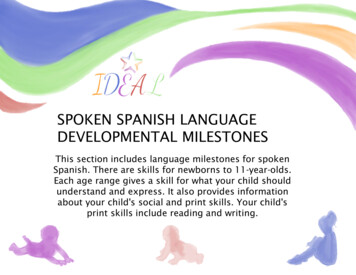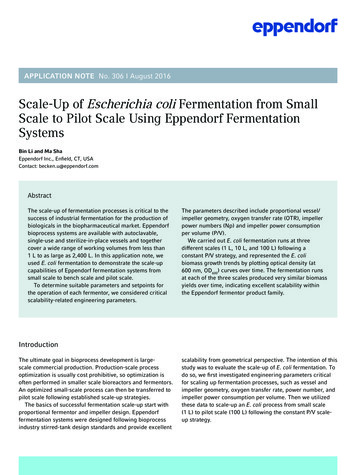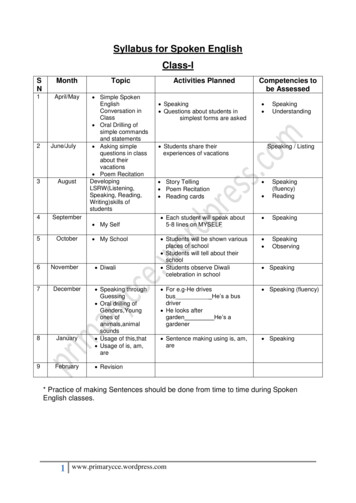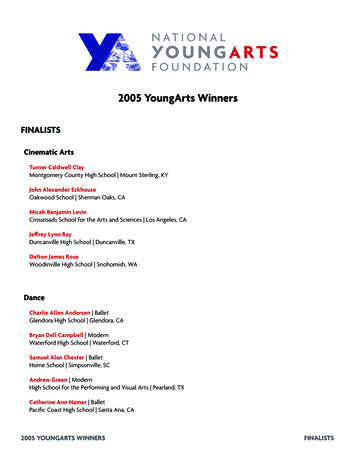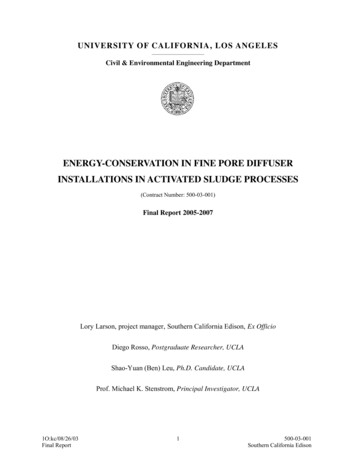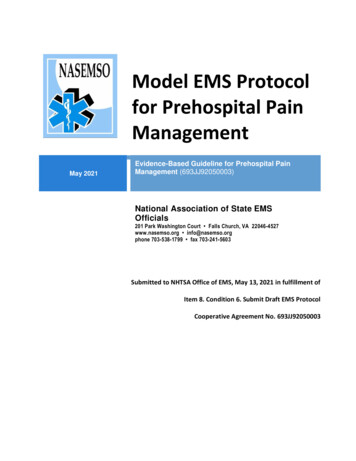
Transcription
Large Scale Training through Spoken Tutorials to Promote and useOpenModelicaKannan M. Moudgalya11 Dept.Bhargava Nemmaru1 Kaushik Datta1Peter Fritzson2 Adrian Pop2Priyam Nayak1Rahul Jain1of Chemical Engineering, Indian Institute of Technology Bombay, ayak.priyam22,rahjain1}@gmail.com2 Dept.Computer and Information Sciences, Linköping University, he step-by-step self-teaching approach through audiovideo tutorials, known as Spoken Tutorials, has been verysuccessful. About 3.4 million students in India have takenat least one course during the past 6-year period, of which1.6 million students have attended the rapidly expandingcourse programme during 2016. This programme has nowbeen expanded by a newly developed course in Modeling and Simulation with Modelica using the OpenModelica open source tool, primarily via the OMEdit graphicaluser interface. The spoken tutorial programme is exclusively based on free and open source software. This papergives an introduction to the spoken tutorial approach andpresents the recently developed spoken tutorial series forModelica using OpenModelica. Feedback of participantsshows that this series is an effective tool for self-learningof OpenModelica. The paper also presents a new webversion that generalises the interactive DrModelica coursematerial, OMWebbook: it enables students to learn Modelica, do text-based modeling exercises, and run simulations without needing to install a Modelica tool. OMWebbook is also planned to be covered in a future update tothe spoken tutorial course on Modelica.Keywords: Spoken Tutorial, tutorial, Modelica, OpenModelica, teaching, self learning, modelling, simulation1IntroductionModelling and simulation is the most cost effective wayfor a developing country like India to become a developedone. For example, the warning issued by the Indian SpaceResearch Organisation (ISRO) saved 10,000 lives recently(Laxman, 2016). It is well known that satellites help locatearable land, help predict locations in seas with fish population, etc. India’s advances in the satellite technology arerooted in modelling and simulation. ISRO’s interplanetarymissions are said to be most cost and time effective, oneof the reasons being the extensive use of simulation (EconomicTimes, 2013). Improving the modelling and simulation ethos amongst the academics can help derive suchbenefits in other sectors also.Free and open source software (FOSS) is equally imDOI10.3384/ecp17132275portant to a developing country like India. Use of proprietary software results in an outgo of 1 billion everyyear, in education and police sectors alone (De, 2009).This precious foreign exchange can be more usefully spentin priority sectors like poverty alleviation and infrastructure development. Because of this, the Indian government has made the use of open source software mandatory, whenever it is of comparable capability to commercial software for the tasks at hand (Govt. of India, 2015).As OpenModelica implements the complete Modelica language (Modelica-Association, 2012) and is an open sourceimplementation, we have selected it to promote the modelling and simulation culture in India. The award winning Spoken Tutorial method is selected for this promotion (Google, 2015; QS&Wharton, 2015).This paper is organised as follows. We begin with abrief explanation of the Spoken Tutorial methodology insections 2 and 3. We list the Spoken Tutorials created onOpenModelica in section 4. We then explain in section5 how to use these tutorials for effective learning withoutexperts. In section 6, we explain the cloud environmentOMWebbook In the final section, we conclude the paperwith a discussion on future work.2Spoken TutorialsA Spoken Tutorial is a ten minute long audio-video tutorial, created using the Screencast technology. It is wellknown that the optimal time for a video tutorial is about 9minutes (Guo, 2013).Here we use the tutorial concept in a slightly differentway from a conventional 2-3 hour lecture-based tutorial.Spoken Tutorial is a smaller modular piece of active learning: A typical student following such an audio-video tutorial is expected to pause/replay the video and reproduceevery command. To enable this, all the files used in thevideo are also seamlessly made available to the learner. Asthe software covered is open source, the student can download it, and practise the tutorial side-by-side. There arealso exercises to perform. A beginner could easily spendhalf an hour to practise a 10 minute Spoken Tutorial, whilean advanced learner may complete it in less time.Spoken Tutorials are created to explain general IT con-Proceedings of the 12th International Modelica ConferenceMay 15-17, 2017, Prague, Czech Republic275
Large Scale Training through Spoken Tutorials to Promote and use OpenModelicacepts. Although only a small amount of information maybe covered in ten minutes, one can cover advanced topicsas well through a series of tutorials. The following factorsdistinguish this methodology:2. As it was difficult to find free slots, we mapped Spoken Tutorials to lab courses and encouraged learning during lab hours. As they do not have access togood teachers, most students in India find this a valuable resource that helps them understand the subject,score well in exams and get jobs.1. Spoken Tutorials are created for self learning. Wewrite the script before making the video. The scripthas to be certified as understandable by a beginner,before it is taken up for recording.3. We convinced university authorities, curriculumboards and syllabus committees to use Spoken Tutorials officially in their lab courses. More than 100universities, each of which has about 50 to 500 affiliating colleges, have accepted the Spoken Tutorial methodologies, and have sent circulars recommending the use. At present, there are about 20,000semester long lab courses that officially use SpokenTutorials.2. Spoken Tutorials are released through Creative Commons Attribution Share Alike (CC-BY-SA) licensefrom our website (Spoken-Tutorial-Project, 2017b).3. Spoken Tutorials are created on open source softwareonly. As a result, anyone who wants to learn usingSpoken Tutorial, can download and practise with thecorresponding software.4. We now insist that we work only with colleges thatagree to train ALL their students through Spoken Tutorials. This and the previous point have helped ustrain a really large number of students in the first fullyear of implementation, which is 2016, see Figure 1.We have trained a total of 2.8 million people in thepast five years, reaching 1.6 million in 2016 alone.200,000 people have already enrolled for our training during the first 20 days of this calendar year.4. We make available all the code, data files, etc., thatare required in a tutorial, see Figure 6. This allowsthe learner to reproduce all the commands shown inthe tutorial. This also allows a learner to start learning from any tutorial, obviating the need to go in aparticular sequence.5. We use the side-by-side method of learning throughSpoken Tutorials. A schematic of the arrangementis given in Figure 7. This arrangement reduces thecognitive overload of learners (Moudgalya, 2014).5. We provide online tests and certificates to collegestudents who pass them. These are offered free ofcost, thanks to the funding from our government.6. We dub the spoken part of Spoken Tutorials into all22 official languages of India. For this, we time thescript, which needs to be done only once. The factthat the video is in English helps from the employment perspective of our students. We have dubbedsome of our tutorials also into some languages ofthe Middle East, South East Asia, Latin America andAfrica. As our tutorials are available under the CCBY-SA license, these are available to everyone.6. Our website (Spoken-Tutorial-Project, 2017b) alsoreceives a large number of visitors. In Figure 2, wepresent the statistics of visitors to our web page. Itshould be noted that most of our learners using theoffline learning material, created using the facilitydescribed in Figure 4, which has increased the number of learners 50 times, as reported in Figure 2.7. The web statistics are good from the view of other7. We have about 800 tutorials made into English, covparameters as well. For example, the averageering about 40 topics, such as, C, C , Java, Python,time one spends on our web page (Spoken-TutorialPHP, Perl, Ruby, Scilab, LATEX, LibreOffice andProject, 2017b) is about 10 minutes and the bounceDWSIM. We have about 5,600 dubbed tutorials. Thisrate is about 30%, as can be seen from Figure 3.is the largest collection of IT training material in Indian languages.We can use the procedure presented in this section to teachand thereby promoting OpenModelica and the Modelica3 Large Scale Training with Spoken language.Tutorials4OpenModelica Spoken TutorialsWe now briefly explain the way we have used Spoken TuWe created ten Spoken Tutorials on OpenModelica, astorials to promote IT literacy:shown in Table 1. In this Table, we have listed the title1. We initially offered 2 hour free training to college of these tutorials and their learning objectives. The averstudents and faculty, to be done outside college age time of these tutorials is about 13 minutes, with thehours. As Spoken Tutorials are created for self learn- minimum of 8 minutes and a maximum of 15 minutes.ing, presence of an expert is not necessary. Any inter- Although these are the first set of tutorials we created onested person could organise a training session, using OpenModelica, we have numbered them from 4, becausethe resources at the college.of reasons to be explained next.276Proceedings of the 12th International Modelica ConferenceMay 15-17, 2017, Prague, Czech RepublicDOI10.3384/ecp17132275
Session 6: Poster SessionNumber of students/teachers trained in their colleges/schools1,600,0001,400,0001,200,000Table 1. Summary of Spoken Tutorials on OpenModelicaNo.4NameDevelopinganequation basedmodel5ControlflowandeventhandlingFunctionsand 0122,0132,0142,0152,016Figure 1. Growth of students/teachers trained. Our insistencethat every student should be trained on at least one topic, andmapping to course content, have resulted in a large growth in2016. The total number trained until now is about 3 million.67Arrays inModelica8Array functions andoperations9ModelicaPackages10Annotationsin delling13BlockcomponentmodellingFigure 2. Growth of visits to ST website (Spoken-TutorialProject, 2017b). This can be obtained by visiting (StatCounter)and choosing Yearly dataIn a recently held workshop (FOSSEE-Team, 2017), allthe participants were asked to self-learn OpenModelicausing Spoken Tutorials. We received the following feedback from the participants about the use of Spoken Tutorials: . the detailed step-by-step descriptions made it easyto learn the basics of OpenModelica. Is is good for beginners. I suggest you to showcasemore application use cases for the advanced use. . very good , we have learned much from spokentutorial. Spoken Tutorials are easy to Understand.Learning ObjectivesCreate a new Modelica class, variables, parameters and equations.Assign initial, minimum and maximum values. Simulate model andsee results.Explain if-else statements, timeand state events, when statement,and reinit function.Define functions, data types, inputand output variables, assignmentstatements, and the algorithm section. Evaluate a polynomial.Define vectors, vector indexing,array variables, for and whileloops, and nested for loop.Explain OMShell, array construction function and perform arithmetic operations on vectors andmatrices.Create a package of classes, reference classes in a package, importstatement, and using Modelica library.Specify an annotation and definea record. Explain through experiment, model and documentationannotations.Specify icon and diagram viewsof a class, insert a polygon andan ellipse in icon/diagram view.Introduce coordinate system, gridand components. Explain originand extent concepts, and line andfill styles.Instantiate classes. Define component orientation, acausal connectors, resistors, sources and theground. Connecting classes andpins.Define blocks and connect them.Use MISO blocks and Modelicalibraries. Define RealInput andRealOutput connectors. Instantiate sum and product functions. . up to some extent this tutorial make learning easier but we should make some more basic tutorial onOpenModelica.Figure 3. Analysis of visitor statistics of Spoken Tutorial, givenby SimilarWeb (Team)DOI10.3384/ecp17132275 In my opinion side by side tutorials are the best wayto start learning a new software. In order to masteranything it will take a lot of practice of course butProceedings of the 12th International Modelica ConferenceMay 15-17, 2017, Prague, Czech Republic277
Large Scale Training through Spoken Tutorials to Promote and use OpenModelicaTable 2. Summary of New Spoken Tutorials on OpenModelicaNo.1NameIntroductionto OMEdit2ExamplesthroughOMEdit3OM ConnectorsLearning ObjectivesIntroduction to OM, OMEdit,opening a class from librariesbrowser, simulating it and seeing the results in plots. Explainthrough a heat transfer example inthermal library.Expose learners to models fromelectrical and mechanics libraries,using rectifier and double pendulum classes. Simulate and see theresults in plots.Train how to compose existing objects to create a new circuit. Concept of connectors introduced. Explain through resistor,capacitor, inductor, voltage sourceand ground.having the basics right makes practice a lot easier. Tutorials are excellent. If you could include tutorials on popular extensions available on Modelica,it would be a great help. For example, the devicedrivers library.5Method to Use OpenModelica Spoken TutorialsWe now explain how to use OpenModelica Spoken Tutorials. One should remember that our method should be suchthat any volunteer can conduct these workshops. As volunteers may not know answers to questions the learnersmay have, we insist on only reproducing what is shownin Spoken Tutorials: the learner does not know anything,so why not first do the things suggested in the tutorial?The pros and cons of this approach are summarised in(Moudgalya, 2011). We also offer a timed forum thatwill help the learner to go through the answers of previous questions and to ask new questions (Spoken-TutorialProject, 2017a).The first thing to do is to create an offline version usingthe create the cdcontent utility, as shown in Figure 4. Of course, this has to be done only by the organiserof the workshop. This will create a zip file, which has tobe unzipped and copied on to every computer thereafter.We now summarise the recommended way to use SpokenTutorials to conduct an OpenModelica self-learning workshop:1. Open the file index.html using Firefox orChrome. Internet Explorer may not work correctly.One gets the page as shown in Figure 5. From the urlinside the red box in this figure, one can see that thelearning content comes from the file system.Tutorials in Table 1 were created as per the pedagogy2. Listen to the side by side spoken tutorial thatwe use in classes: teach the underlying language first. Butappears on this page. This tutorial explains how thethis is not necessarily the best way when it is offered forlearner has to use this method. After that, one hasself learning. Students who depend on commercial simto Select Foss Category and then Selectulators are used to the plug and play method of learning,Language and then Submit - these options are enwhich is possible in OpenModelica if one uses the preclosed in a green box in Figure 5.defined models that come with the distribution. This will3. The learner has to learn all the tutorials in the resultalso reduce the fear of first time users.ing play list one by one. From the play list, one canTo address the above issue, we created two more tutoriselect any tutorial. If one scrolls down, one can seeals. The first one explains how heat transfer modelling canif any code file comes with that tutorial. In Figure 6,be done. The second tutorial is concerned with examplesone can see where the code files are available.from Electrical Engineering and Mechanical Engineering.These two tutorials are created for the absolute beginners,4. Figure 7 shows how to open the Spoken Tutorial andwho would like to learn how to use the already availablethe OpenModelica software side by side. Using themodels.side-by-side method (Moudgalya, 2014), the learnerWe created one more tutorial to explain how to connecthas to reproduce every command described in the tupredefined models. Such a facility is generally availabletorial. The learner has to do the assignments also.in commercial simulators. Introduction to this capabilityAs a result, the learner ends up spending a lot moreright at the beginning increases the value of the simulatortime, even though the tutorial itself may only be ofin the opinion of the learner. In this tutorial, we show howten minute duration.to connect the preexisting blocks to build a new model.We now ask new learners to practise these tutorials, before5. Using the method explained above, one has to learnstarting with the ones in the previous section.learn all Spoken Tutorials in the play list.These new tutorials are listed in Table 2. Although created later, they are numbered from 1, as we recommend The above given explanation is for the offline user. Thethese to be practised first, before proceeding to the ones same procedure will work for online use of Spoken Tutolisted in Table 1.rials.278Proceedings of the 12th International Modelica ConferenceMay 15-17, 2017, Prague, Czech RepublicDOI10.3384/ecp17132275
Session 6: Poster SessionIn the six month time since we created Spoken Tutorials under discussion, we have trained more than 5,000people on OpenModelica. As this is achieved through theself learning of already created Spoken Tutorials, there isa potential to train many more.needed. Figure 10 shows a small part of a chemical engineering course book in OMNotebook and OMWebbookwith some formulae that have been typeset using this approach.We propose to develop Spoken Tutorials on DrModelica, OMNotebook and OMWebbook in the near future.6 Cloud Environment OMWebbook This will help beginners to quickly learn how to use theseto Ease Learning of OpenModelica powerful tools and hence will further ease the learning ofOpenModelica. Given that modelling and simulation areDrModelica (Lengquist-Sandelin et al., 2003) is an in- advanced topics for most students in India, we need all theteractive electronic document for learning Modelica text- tools to make them accessible.based modeling and simulation using the OpenModelicatool OMNotebook. It is structured like a book, with chap- 7 Conclusions and Future Workters, sections, model examples, exercises, formulae, andIn this work, we have outlined a procedure to improvefigures (Asghar et al., 2011). The recent versions of Drthe modelling and simulation ethos in India and elsewhereModelica contain most of the model examples in (Fritzthrough Spoken Tutorial enabled self-learning of Openson 2014) in an editable and executable form, includingModelica. Based on the user feedback, we are in theplots of simulated models. DrModelica is intended forprocess of increasing the offering of Spoken Tutorials onself-learning and includes exercises with solutions, whereother OpenModelica topics. Through this effort, the powthe solutions are temporarily hidden while the student iserful modelling paradigm of Modelica is expected to reachworking on a problem. Thus, it is extremely useful tomany people in India.everyone, and especially to the beginning learners of theIn the companion paper presented by our group in thisModelica language and the OpenModelica tool.conference (Jain et al., 2017), we have explained how theRecently we have developed a web-based verfeatures of OpenModelica have been extended to make itsion of OMNotebook, called OMWebbook (http:useful to chemical engineers. We seek such contributors//omwebbook.openmodelica.org/) which enablesin other domains too. We hope to promote the use of theediting models, running simulations, and doing plots in aModelica language and the OpenModelica tool with speweb-page (Figure 8). The appearance is very similar tocific focus on different domains of application.the OMNotebook. Thus, the students need not install anyWe also seek collaborators who would want to makeModelica tool on their computer. They do not even need aavailable this important technology in their countries.computer, the exercises can be done using a phone or pad.OMWebbook communicates with a server that performs Acknowledgementsthe actual simulation and plots. Naturally, those who donot have bandwidth to access the Internet can use OM- This work has been supported by Swedish Vinnova governmental agency and the Indian DST governmentalNotebook.OMNotebook, and also OMWebbook, have recently agency in the Indo-Swedish RTISIM project, and by thebeen enhanced with support for typesetting Mathemati- National Mission on Education through ICT, Ministry ofcal formulae using LATEX commands (Asghar et al., 2011). Human Resource Development, through the Spoken TutoThese commands are associated with a formulae cell (Fig- rial project. The OpenModelica development is supportedure 9) but can be hidden (Figure 10) when editing is not by the Open Source Modelica Consortium.DOI10.3384/ecp17132275Proceedings of the 12th International Modelica ConferenceMay 15-17, 2017, Prague, Czech Republic279
Large Scale Training through Spoken Tutorials to Promote and use OpenModelicaFigure 4. Creating a zip file of all tutorials for offline use, using the cdcontent facilityFigure 5. Unzipped content, opened in Firefox or Chrome. Internet Explorer may not work correctly. The URL inside the red boxpoints to a file. One has to first listen to the side-by-side method tutorial. After that, one selects the FOSS, then the language, suchas English, and then Submit. This will give a play list. One can then open any of the tutorials and practise side by side, as shownin 7280Proceedings of the 12th International Modelica ConferenceMay 15-17, 2017, Prague, Czech RepublicDOI10.3384/ecp17132275
Session 6: Poster SessionFigure 6. In the selected tutorial, one has to scroll down to locate the code files. Its location is indicated by the red oval in theabove figure. Code files help the learner reproduce every command.Figure 7. Side-by-side method. On the left hand side, we have the spoken tutorial, developing an equation based model. On theright hand side, OMEdit is displayed. The code file that came with the tutorial is opened in OMEdit.DOI10.3384/ecp17132275Proceedings of the 12th International Modelica ConferenceMay 15-17, 2017, Prague, Czech Republic281
Large Scale Training through Spoken Tutorials to Promote and use OpenModelicaFigure 8. Example using OMWebbook on the simple HelloWorld model in DrModelica282Proceedings of the 12th International Modelica ConferenceMay 15-17, 2017, Prague, Czech RepublicDOI10.3384/ecp17132275
Session 6: Poster SessionFigure 9. Type-setting mathematical formulae in OMNotebook using LATEX commandsFigure 10. Example of finished typesetting of mathematical formulae in OMNotebook and OMWebbookDOI10.3384/ecp17132275Proceedings of the 12th International Modelica ConferenceMay 15-17, 2017, Prague, Czech Republic283
Large Scale Training through Spoken Tutorials to Promote and use OpenModelicaReferencesA. Asghar, S. Tariq, M. Torabzadeh-Tari, P. Fritzson, A. Pop,M. Sjölund, P. Vasaiely, and W. Schamai. An Open SourceModelica Graphic Editor Integrated with Electronic Notebooks and Interactive Simulation . In Proc. of the 8th International Modelica Conference 2011, pages 739–747, Linköpinguniversity, Sweden, 2011.R. De.Economic impact of free and open sourcesoftware - a study in india.Technical Reporthttp://www.iimb.ernet.in/ rahulde/RD FOSSRep2009.pdf, IIM Bangalore, 2009.EconomicTimes. Why isro’s mars mission is the 24982272.cms, 31 Oct. 2013.FOSSEE-Team.Openmodelica workshop.fossee.in/workshop/om/, 4-5 Jan. 2017.http://Google.Google mooc focused research ouncing-google-mooc-focusedresearch.html, March 2015. Last seen on 22 Jan.2017.Govt. of India.Policy on adoption of open sourcesoftware for govt. of india.Gazette source-software-forgovt-of-india/, 2015. English notification is givenafter that in Hindi. Last seen on 22 Jan. 2017.P. Guo.Optimal Video Length for Student Engagement. See nt-engagement, 2013. Lastseen on 3 April il-nadu/articleshow/55992320.cms, 17 December 2016. Last seen on 3 April2017.EL. Lengquist-Sandelin, S. Monemar, P. Fritzson, and P. Bunus.DrModelica - An Interactive Tutoring Environment for Modelica. In Proceedings of the 3rd International Modelica Conference, Linköping, Sweden, 3-4 Nov. 2003.Modelica-Association. Modelica: A unified object-oriented language for physical systems modeling, language specificationversion 3.3. http://www.modelica.org/, May 2012.K. M. Moudgalya. LATEX Training through Spoken Tutorials.TUGboat, 32(3):251–257, 2011.K. M. Moudgalya. Pedagogical and Organisational Issues inthe Campaign for IT Literacy Through Spoken Tutorials. InR. Huang, Kinshuk, and N.-S. Chen, editors, The new development of technology enhanced learning, chapter 13, pages223–244. Springer-Verlag, Berlin Heidelberg, 2014.QS&Wharton.Reimagine education 2015:Spoken Tutorial is Placed First in the Nurturing Employability Award a1464d4b6b70ee0f/Indian Institute of Technology Bombay%22,Dec.2015.Spoken-Tutorial-Project.Online forum.See http://forums.spoken-tutorial.org/, 2017a. Last seen on3 April 2017.Spoken-Tutorial-Project. Official web page. See http://spoken-tutorial.org/, 2017b. Last seen on 3 April2017.R. Jain, K. M. Moudgalya, P. Fritzson, and A. Pop. Developmentof a Thermodynamic Engine in OpenModelica. In 12th Int.Modelica Conf., Prague, 2017. Modleica Association.StatCounter. Summary log. http://statcounter.com/p5528933/summary/?account id 2904483&login id 5&code 9f03e451b379437c7356d2529c726a7a&guest login 1. Last seen on 12 Dec. 2016.S. Laxman.Cyclone Vardah: ISRO satellites saved10,000 lives in Tamil Nadu.Times of India,Similar Web Team. Get insights for any website or app. https://www.similarweb.com/. Last seen on 12 Dec. 2016.284Proceedings of the 12th International Modelica ConferenceMay 15-17, 2017, Prague, Czech RepublicDOI10.3384/ecp17132275
user interface. The spoken tutorial programme is exclu-sively based on free and open source software. This paper gives an introduction to the spoken tutorial approach and presents the recently developed spoken tutorial series for Modelica using OpenModelica. Feedback of participants shows that this series is an effective tool for self-learning
